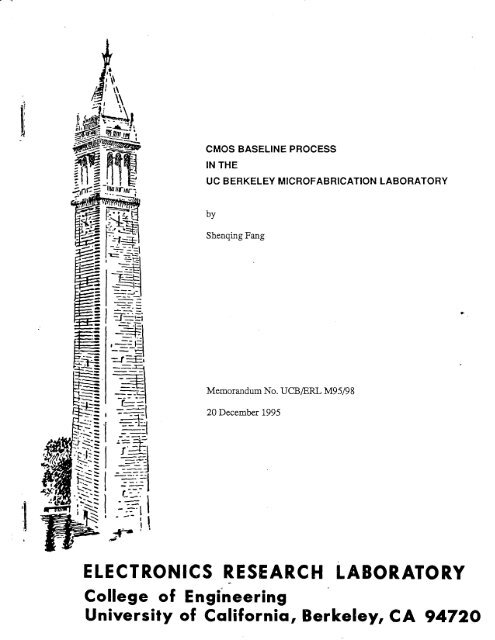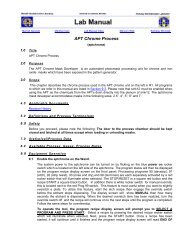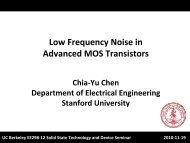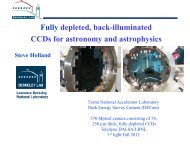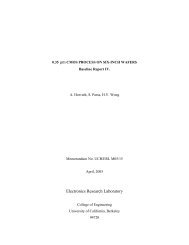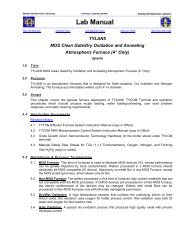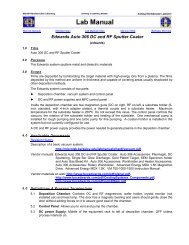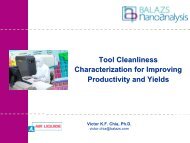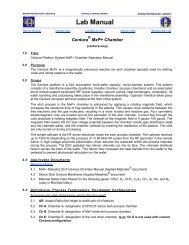Report I: CMOS Baseline Process (pdf) - Berkeley Microlab ...
Report I: CMOS Baseline Process (pdf) - Berkeley Microlab ...
Report I: CMOS Baseline Process (pdf) - Berkeley Microlab ...
Create successful ePaper yourself
Turn your PDF publications into a flip-book with our unique Google optimized e-Paper software.
<strong>CMOS</strong> BASELINE PROCESS<br />
IN THE<br />
UC BERKELEY MICROFABRICATION LABORATORY<br />
by<br />
Shenqing Fang<br />
Memorandum No. UCB/ERL M95/98<br />
20 December 1995<br />
ELECTRONICS RESEARCH LABORATORY<br />
College of Engineering<br />
University of California, <strong>Berkeley</strong>, CA 94720
<strong>CMOS</strong> <strong>Baseline</strong> <strong>Process</strong><br />
in the<br />
UC <strong>Berkeley</strong> Microfabrication Laboratory<br />
Shenqing Fang<br />
Electronics Research Laboratory<br />
College of Engineering<br />
University of California, <strong>Berkeley</strong><br />
December, 1995<br />
Abstract<br />
This project describes the characterization of the <strong>Berkeley</strong> <strong>CMOS</strong> <strong>Baseline</strong>, a joint project by sev-<br />
eral research groups. The process supports 2 (im n-well technology, with double poly-Si, double<br />
metal, and defines the standard process modules in the <strong>Microlab</strong>. Statistical process control data,'<br />
geometric design rules and BSIM3 SPICE model parameters are presented.
<strong>CMOS</strong> <strong>Baseline</strong> <strong>Process</strong> in the UC <strong>Berkeley</strong> Microfabrication Laboratory<br />
Table of Contents<br />
1 Introduction . 3<br />
2 <strong>Process</strong> Design 5<br />
2.1 <strong>Process</strong> Flow and Device Cross Sections<br />
2.2 Mask Definitions<br />
3 <strong>Process</strong> Simulation and Material Characterization...., 9<br />
3.1 N-Channel<br />
3.2 P-Channel<br />
3.3 N+Source-Drain<br />
3.4 P+Source-Drain<br />
4 Electrical Measurement Results 15<br />
4.1 HP4145 Measurement Results<br />
4.2 Statistical Measurement Data<br />
5 SPICE Parameter Extraction 28<br />
6 Summary 35<br />
References 36<br />
Appendix A 2 [im N-Well, Double Poly-Si and Double Metal <strong>CMOS</strong> <strong>Process</strong><br />
and Device Parameter Targets 37<br />
Appendix B 2 [im N-Well, Double Poly and Double Metal <strong>CMOS</strong> Design Rules 38<br />
Appendix C <strong>Microlab</strong> <strong>CMOS</strong> <strong>Baseline</strong> <strong>Process</strong> Log '. 40
1 Introduction<br />
In an educational laboratory like the UC <strong>Berkeley</strong> Microfabrication Laboratory, each project is<br />
different and students need to identify a starting point from which they can carry on their own<br />
research. This is one of the reasons why the <strong>Microlab</strong> reestablished the baseline <strong>CMOS</strong> process in<br />
April 1992, based on the previous <strong>Microlab</strong> <strong>CMOS</strong> process [1]. The baseline also serves to moni-<br />
tor <strong>CMOS</strong> process equipment, to quickly discover and fix process problems, and to specify stan-<br />
dard process modules for VLSI operations. We have developed both p-well and n-well, 2 (im,<br />
double poly and double metal <strong>CMOS</strong> processes and while these are.running we embarked upon<br />
developing a 1.3 |im, twin-well, double poly, double metal <strong>CMOS</strong> process.<br />
Our baseline provides "standard" <strong>CMOS</strong> circuits to various research groups. The advantage is that<br />
the designers are close to processing, can follow it in detail, can feedback their circuit perfor-<br />
mance results to process engineering and thus improve the process. The baseline has fabricated<br />
lots for several research groups: The <strong>Berkeley</strong> Sensor and Actuator Center (BSAC), the <strong>Berkeley</strong><br />
Computer Aided Manufacturing (BCAM) group, the Solid-State Devices and Technology group,<br />
the Cryoelectronics Research group, and the Integrated Circuits group. The baseline process con-<br />
sists of standard steps. Each process step can also be used as a process module by different groups<br />
for their own process design.<br />
Statistical process control (SPC) has been applied to the baseline. Standard in-line measurements<br />
have been established to monitor critical steps. The electrical test structures, designed by David<br />
Rodriguez [2] for testing on an automatic probe station, enable collection of statistical data. The<br />
test structures are placed in the scribe lanes of each wafer. Tests are performed on each wafer and
the resulting data are statistically analyzed to determine whether the process Is in control.<br />
During the development of our baseline process, we compared the n-well and p-well processes<br />
and found that the n-well process has the advantage of fewer process steps, easier threshold volt-<br />
age control, and better device performance. In this memo we will describe the n-well <strong>CMOS</strong><br />
baseline process in detail, with process simulations, materials characterization and electrical mea-<br />
surement results. <strong>Process</strong> and device parameter targets and circuit design rules are also included.
2 <strong>Process</strong> Design<br />
The <strong>Microlab</strong>'s 2 Jim, double poly and double metal <strong>CMOS</strong> process was designed mainly for ana-<br />
log circuit fabrication. The objective is to fabricate good performance 2 (J.m <strong>CMOS</strong> circuits with a<br />
simple and stable process. The process has 5 implant steps and 11 lithography steps. The starting<br />
material is a 4" 8-12 Q-cm p-type, wafer, on which 2jim N-channel MOSFETs can be fab-<br />
ricated without a punchthrough implant. There is no n-field implant, because the phosphorus con-<br />
centration at the n-well surface is high enough for a field threshold voltage greater than 12V. The<br />
baseline process specifications are given in Appendix A.<br />
2.1 <strong>Process</strong> Flow and Cross Sections<br />
A brief process flow with device cross sections is shown in Figure 1. All the process steps are<br />
done in the <strong>Microlab</strong> with the exception of ion implant steps, which are carried out at Ion Implant<br />
Services (Sunnyvale, California). The detailed information is in the process outline in Appendix<br />
C, which includes the equipment used in the <strong>Microlab</strong> for the <strong>CMOS</strong> process.<br />
Well Implant<br />
P-Field Implant<br />
<strong>Process</strong> Step<br />
Threshold Adjustment Implant<br />
N+ S/D Implant<br />
P+ S/D Implant<br />
Ion Implantations<br />
Species<br />
Phosphorus<br />
Boron<br />
Boron<br />
Arsenic<br />
Boron<br />
Energy (KeV)<br />
150<br />
70<br />
30<br />
160<br />
30<br />
Dose (/cm2)<br />
5xl012<br />
l.SxlO13<br />
l.TxlO12<br />
5xl015<br />
5xl015
2.2 Mask Definitions<br />
Mask Name<br />
NWELL<br />
ACTIVE<br />
PFIELD<br />
POLY<br />
CAP-CE<br />
N+S/D<br />
P+S/D<br />
CONT<br />
METAL1<br />
VIA<br />
METAL2<br />
chrome<br />
emulsion<br />
emulsion<br />
emulsion<br />
emulsion<br />
chrome<br />
emulsion<br />
chrome<br />
emulsion<br />
chrome<br />
emulsion<br />
Type<br />
dark<br />
clear<br />
clear<br />
clear<br />
clear<br />
dark<br />
clear<br />
dark .<br />
clear<br />
dark<br />
clear<br />
Field<br />
Align Sequence<br />
NWELL<br />
ACTIVE<br />
ACTIVE<br />
POLY<br />
POLY<br />
POLY<br />
POLY<br />
CONT<br />
METAL1<br />
VIA
2 um <strong>CMOS</strong> <strong>Process</strong> Flow and Cross Sections<br />
Phosphorus<br />
1 1 1 1 1 1 I U U H U H<br />
Photoresist<br />
Oxide<br />
p-typeSi 8-12 ohm-cm<br />
Boron<br />
m i u H u u u m u<br />
Photoresist 2<br />
Pad<br />
oxid"ev^<br />
Photoresist 1<br />
' "•%i«*'^v * j<br />
-, ."3®&£'.k* ;„<br />
**•<br />
p-typc Si<br />
Boron<br />
Photoresist 1<br />
^R^^^i-iC;.'!<br />
N-wcll<br />
U t I U \ H H I t i H<br />
v. ' ^~<br />
FOX :<br />
p-type Si<br />
\<br />
N-well<br />
Fig. 1 <strong>Process</strong> flow and cross sections.<br />
1. Initial oxidation: lOOnm oxide<br />
2. Well photo<br />
3. Well implant:<br />
12 2<br />
phosphorus, 150KeV, 5x10 /cm<br />
4. Well drive-in: Xj = 3.4um<br />
5. Pad oxidation: 30 nm<br />
6. Nitride deposition: lOOnm<br />
7. Active area photo (PR1)<br />
8. Nitride etch<br />
9. P-field photo (PR2)<br />
double photoresist process<br />
10. P-field implant:<br />
13 2<br />
boron, 70KeV, 1.5x10 /cm<br />
11. LOCOS:<br />
field oxide (FOX): 650-700nm<br />
12. Nitride removal<br />
13. Pad oxide removal<br />
14. Sacrificial oxide: 20nm<br />
15. Threshold implant:<br />
boron, 30KeV, 1.7x10 /cm2
p-typc Si<br />
p-type Si<br />
p-type Si<br />
gate poly<br />
Fig. 1 (cont.) <strong>Process</strong> flow and cross sections.<br />
16. Sacrificial oxide removal<br />
17. Gate oxidation: 30nm<br />
18. Gate poly deposition:<br />
450nm<br />
19. Gate poly photo<br />
20. Gate poly etch<br />
21. Capacitor oxidation:<br />
80nm on poly<br />
22. Capacitor poly deposition:<br />
450nm<br />
23. Capacitor photo<br />
24. Capacitor etch<br />
25. N+ S/D photo<br />
26. N+ S/D implant<br />
As, KSOKeV, SxldVcm2<br />
27. N+ S/D anneal<br />
28. P+ S/D implant<br />
B,30KeV,5xltfs/on?<br />
29. PSG deposition: 700nm<br />
and densiflcation<br />
30. Contact photo<br />
31. Con tact etch<br />
32. Al sputtering: 600nm<br />
33. Al definition<br />
34. PECVD thin oxide: 40nm<br />
35. Spin-On-Glass SOOnm<br />
36. PECVD thick oxide: 300nm<br />
37. VIA photo<br />
38. VIA etch<br />
39. Al sputtering: 800-900nm<br />
40. Al photo<br />
41. Al Etch<br />
42. Sintering
3 <strong>Process</strong> Simulation and Material Characterization<br />
The results of SUPREM3 and Spreading Resistance Analysis (SRA) are presented here. The SRA<br />
was performed by Solecon Laboratories (San Jose, CA). The SRA samples were made from the<br />
lot cmos39.<br />
3.1 N-Channel<br />
Doping profiles in the N-channel region are shown in Figures 2 and 3. The simulated gate oxide<br />
thickness is 29.2 nm. The simulated surface concentration (3.9xl016/cm2) is about two times of<br />
that from SRA (2xl016/cm2). In Section 4, we will see the SRA result is close to the statistical<br />
data obtained from electrical measurements on cmos39. See Figure 24 (a).<br />
3.2 P-Channel<br />
Figures 4 and 5 are the doping profiles in the P-channel region. From simulation, the well junction<br />
depth and threshold implant junction depth are 3.4231 and 0.24135 |j.m, respectively. SRA data<br />
show a shallower N-well junction of 2.748 (im and no threshold implant junction. However, SRA<br />
P+ source-drain profile in Figure 9 shows an N-well junction depth of 3.224 Jim which is close to<br />
the simulation result.
25<br />
to<br />
s;<br />
o<br />
£T<br />
£L<br />
D.<br />
•§ CO<br />
«—*•<br />
I<br />
o><br />
Cfl<br />
i<br />
Q.<br />
cr<br />
v;<br />
GO<br />
G<br />
7^<br />
W<br />
2<br />
A<br />
a.<br />
•8 V<br />
f-f<br />
•a<br />
O<br />
cr<br />
»_<br />
a><br />
a.<br />
^o<br />
3<br />
GO<br />
01<br />
log (Concentration (t/on"3))<br />
O<br />
O<br />
0)<br />
D<br />
O<br />
Hi<br />
H-<br />
1—'<br />
0)<br />
H-<br />
3<br />
O<br />
0)<br />
CD
Dopant Profile in P-Channel<br />
10<br />
i nr ij,<br />
Carrier<br />
Concentration<br />
(cm-3) 101<br />
?PP<br />
0 1 2 3 4 5 (<br />
DEPTH - microns<br />
Date 6/1/95 Probe road 2.8 g Orientation Si<br />
File | SJEC1131 Bevel Angle .02059 Step Increm 5 urn<br />
Source U.C.BERKEUX |l|||||l|||ll||i|||imij|j|ji||jn'.g^m Sanple | VTP39<br />
Job I 525212 HlilillllllllHllB.®! ^^.OvWL-7-<br />
Profileby SHETli SHETW =3LJ_|_l=_l...l..jrH BOLECON hi hticd- 2(,IO,.<br />
LABORATORIES ,<br />
1MCMKHATEO<br />
22«1 rfMOOl MiVE IAK JOSE, CA 95131 (W«) «35 7V55<br />
0.00 1.00 2.00 3.00<br />
Distance (Microns)<br />
Fig. 5 P-channel dopant profile obtained from SRA.<br />
Fig. 4 P-channel dopant profile simulated by SUPREM3.
3.3 N+ Source-Drain<br />
The simulated As doping profile (Fig. 6) shows a tail which results in a junction depth of 0.7 jim.<br />
An extrapolation of the doping profile without the tail gives a junction depth of 0.31 fim which<br />
agrees with the SRA result (Fig. 7). The sheet resistance calculated from SRA and measured with<br />
the four-point probe on the same sample are 38 and 37 D/square, respectively. From electrical<br />
measurement, the average sheet resistance is 43.64 Q/square (Fig. 29 (a)).<br />
Parameter<br />
Junction Depth, Xj (u\m)<br />
Sheet resistance (Q/square)<br />
3.4 P+ Source-Drain<br />
Simulated<br />
0.31<br />
Measured from<br />
SRA sample<br />
0.313<br />
38<br />
Calculated<br />
from SRA<br />
37<br />
Electrical<br />
Measurement<br />
43.64<br />
The simulated junction depth (Fig.8) is 0.55784 jim, while the SRA junction depth (Fig 9) is<br />
0.645 |im. The sheet resistance calculated from SRA is 67 Q/square. The four-point probe mea-<br />
surement on the same sample shows 51 Q/square. Both are within the range from 51.5 to 67.5 £><br />
square as can be seen from the average of electrical measurements (Fig. 30 (a)).<br />
Parameter<br />
Junction Depth, Xj (u,m)<br />
Sheet resistance (Q/square)<br />
Simulated<br />
0.55784<br />
Measured from<br />
SRA sample<br />
0.645<br />
51<br />
12<br />
Calculated<br />
from SRA<br />
67<br />
Electrical<br />
Measurement<br />
59.5
log(Concentration (t/cm**3))<br />
cn<br />
a<br />
o<br />
•8 EU<br />
Drr<br />
1-1<br />
O l-h<br />
H-
P+ S/D Dopant Profile<br />
217<br />
19-<br />
g18- Currier<br />
Concentration<br />
(OT-3) 10!*l<br />
Well Implant: Phos., 150 keV, 5E12/cm2<br />
Vt Implant: Boron, 30 keV, l.TE12/cm2<br />
P+ S/D Implant: Boron, 30 keV, 5E15/cm2<br />
Pt S/D Junction Depth: O.SSTB'I microns<br />
PSG Denslfication: 950C, 30 mln.<br />
n-<br />
Net<br />
Boron<br />
— — — — Phosphorus<br />
\<br />
16-<br />
15-<br />
2 3 4<br />
DEPIM - sicrcn*<br />
tot* 6/V93 Prcfa* l£*d 2.8 g ctUntaUon si<br />
riln I SJDG1029 B«V»1 Arigla .021H9 Step Inc«n 2.5 in<br />
U*C,BEKKELEY<br />
o.oo 1.00 2.00 3.00 4.00 5.00<br />
Distance (Microns)<br />
LA'eO'RATO'RIES<br />
1HCO*f«WIt6<br />
2241 PAIUCOH MIVC tM XttC, CA t!13t (UK) Wt 7V$5<br />
Fig. 8 P+ source-drainl dopant profile simulated by SUPREM3, Fig. 9 P+ source-drain dopant profile obtained from SRA.
4 Electrical Measurement Results<br />
The HP4145 Semiconductor Parameter Analyzer and an automatic probe station (autoprober)<br />
were utilized to make electrical measurements on each lot. The autoprober consists of the Electro-<br />
glas Model 200IX, an HP 4085A Switching Matrix, an HP4084 Switching Matrix Controller, an<br />
HP4141A Source/Monitor and a UNIX workstation. The test structures for the autoprober were<br />
designed by D. Rodriguez [2] and they were included in the scribe line of each wafer.<br />
4.1 HP4145 Measurement Results<br />
Figures 10 through 15 are NMOS and PMOS characteristics measured with HP4145. Both<br />
devices have W/L of 10/2.<br />
15
.0000<br />
.0000<br />
ID CuA)<br />
VD .8000/div ( V)<br />
8.000<br />
v«rl«bl«l:<br />
VD -chl<br />
St«rt<br />
Stoo<br />
St«D<br />
st*rt<br />
Scop<br />
St«p<br />
Fig. 10 NMOS drain current vs. drain voltage characteristics.<br />
18.42<br />
1.842<br />
/div<br />
-.0000<br />
.0000<br />
LINE1<br />
LINE2<br />
lecade<br />
/div<br />
1E-12<br />
CURSOR ( 1.2000V 6.883UA . )<br />
MARKER ( 1.2000V . 6.8B3uA . 1<br />
GRAD<br />
15.7E-06<br />
s/r<br />
u_<br />
i /<br />
! 7<br />
V<br />
/<br />
/ft /<br />
x<br />
A /<br />
/<br />
/<br />
,<br />
/f\<br />
/<br />
/ /<br />
//<br />
* // /y<br />
VG .2000/div ( V)<br />
1/SRAD<br />
63.BE+03<br />
Xintercept<br />
7S1E-03<br />
//<br />
/<br />
/<br />
/<br />
//<br />
—<br />
i<br />
2.000<br />
Yintercept!<br />
-11.9E-O6 1<br />
I<br />
Start '<br />
Stoo<br />
Step<br />
-cna<br />
-ens<br />
.oooov<br />
a.oooov<br />
.^ooov<br />
.oooov<br />
7.OOOOV<br />
1. OOOOV<br />
.oooov<br />
.oooov<br />
.OOOOV<br />
2.OOOOV<br />
.O50OV<br />
VSDQ -Ch3<br />
St^rt .OOOOV<br />
Stpp -3.0000V<br />
Step -1. OOOOV<br />
Con*t«nt«:<br />
VO -Chi<br />
VS -CflZ<br />
Fig. 11 NMOS drain current vs. gate voltage characteristics.<br />
CD<br />
t A) CURSOR (<br />
MARKER (<br />
.5500V . 7.90BnA .<br />
.5500V . 7.9O8nA ,<br />
1E-04<br />
1 /<br />
/ ,<br />
^<br />
.<br />
LINE1<br />
LINE2<br />
GRAD<br />
10.4E+00<br />
i<br />
/<br />
y<br />
•f!<br />
\t<br />
1<br />
//<br />
k<br />
VG .2000/dlv (<br />
l/GRAO<br />
96.0E-03<br />
Xintercept<br />
1.33E+00<br />
\0 0<br />
1<br />
— *-<br />
1.400<br />
V] Yintercept<br />
14.7E-15<br />
Fig. 12 NMOS subthreshold characteristics.<br />
16<br />
Start<br />
Stop<br />
Step<br />
St«rt<br />
Stoo<br />
Step<br />
con«t«nt«:<br />
vs -ChZ<br />
VEUB -Cfl3<br />
_O30OV<br />
.OOOOV<br />
-2,OOOOV<br />
a.oooov<br />
.osoov<br />
.oooov<br />
.oooov
.0000<br />
.0000 -10.OO<br />
VO 1.000/div T V)<br />
Fig. 13 PMOS drain current vs. drain voltage characteristics.<br />
ID<br />
CuA) CURSOR C-i. 15OOV . -2,765uA „ 1<br />
MARKER (-1. 1500V .-2.765UA .<br />
y/<br />
]_<br />
\<br />
-6 . 829<br />
/, <<br />
/A<br />
y<br />
.6829<br />
/div<br />
V<br />
/ , / A y ^.<br />
j/ /<br />
1<br />
j \/ y / / A/ i<br />
i<br />
i -7& / /<br />
i i y \/ v /<br />
v/ I<br />
^ i !<br />
\ \e .OOOOV<br />
-.0003<br />
.00 00 -2-000<br />
VG .HOOO/div t V)<br />
GRAD 1 i/GHAO j Xintercept| Yintercept)<br />
LINE11 5.S9E-06! 17BE+03 j -664E-03 ', 3.77E-O6J<br />
LINE2J i 1 i i<br />
Fig. 14 PMOS drain current vs. gate voltage characteristics.<br />
D<br />
t A) CURSOR C- .2500V .-93.90pA .<br />
MARKER (- -2500V -93.90pA .<br />
•iE-0^<br />
7 1<br />
ecade<br />
/div<br />
-1E-12<br />
1<br />
!<br />
i //<br />
GRAD<br />
LINElJ -iO.iE-KK<br />
LINE2<br />
/y<br />
/!/<br />
/y y/<br />
//<br />
i //><br />
//<br />
(<br />
^<br />
k 4--H<br />
"3r~ T<br />
^G .2000 /div ( V)<br />
i/GHAD<br />
-9B.5E-03<br />
1<br />
vn -oil<br />
i_in«*r cx««g<br />
Scant .OOOO V<br />
Stop -iO.OOOV<br />
St«p - ,2000V<br />
vc -chx<br />
Stare .OOOOV<br />
Stoo -7. OOOOV<br />
St«p -1. OOOOV<br />
Can* tan c«;<br />
vs -cna .oooov<br />
VSUS -Ch3 .COOO V<br />
Stop -Z. OOOOV<br />
Step - .O5OOV<br />
v^U8 -Ch3<br />
Star-t .OOOOV<br />
Stop 3.0000V<br />
St«p 1. OOOOV<br />
VO -Chi - .OSOOV<br />
VC -ChZ . OOOOV<br />
j<br />
\0 0 -i.<br />
400<br />
Xintercept Yintercept!<br />
-1.24E+00 -273E-15 |<br />
Fig. 15 PMOS subthreshold characteristics.<br />
17<br />
V«r labial:<br />
VE -C*lX<br />
t_in«*r «pf*<br />
Start .5000V<br />
Stop<br />
— i.SOOOV<br />
Step - .OSOOV<br />
VO -Chi<br />
Start - .03OOV<br />
Ktoo -B.O300V<br />
St«p -3. OOOOV<br />
Cone tan t«:<br />
vs -cha .oooov<br />
VSUS -Ch3 .OOOOV
4.2 Statistical Measurement Data<br />
Autoprober testing enables the baseline to collect large amounts of data for monitoring the pro-<br />
cess and extracting device parameters. Figures 16 through 31 are the statistical results from auto-<br />
prober measurements. For threshold.voltage, fifty-two dies across each wafer were tested and for<br />
other parameters, ten to twenty dies across each wafer were measured. These measured dies were<br />
uniformly distributed across the wafer. Two sets of data, (a) and (b), are presented here. In (a),<br />
each data point is the average of the measurements on one wafer and is connected by a line indi-<br />
cating a process lot. Avg is the average of the data points in the figures, which is the average of a<br />
wafer. UCL and LCL stand for Upper and Lower Control Limits, respectively. In (b), each point is<br />
the standard deviation across the wafer corresponding to the point in (a).<br />
In effective channel length and width measurements (Fig. 18-21), the resistance and conductance<br />
methods [3,4] were used. Ld and Wd are the parameters in the following equations:<br />
Leff = L - AL = L - 2Ld,<br />
Weff=W-AW = W-2Wd.<br />
In Figures 22 and 23, k'_n and k'_p are the current factors (iCox /2 and were measured while the<br />
devices were at saturation.<br />
18
Since the dopant concentration is not uniform in the ion-implanted channel regions, YI and y2<br />
were extracted at low and high substrate bias [5,6]. Based on these results, dopant concentrations<br />
at the surface and substrate (or n-well for PMOS) were obtained. The surface dopant concentra-<br />
tions are shown in Figures 24 and 25. The surface doping concentrations measured this way can<br />
be used to monitor the process, although they are not precise surface doping concentration mea-<br />
surements.<br />
In Figures 27 and 30, cmos39 was not included, because BF2 was implanted to make shallow P+<br />
S/p.junctions for investigation of 1.3 |im PMOS.<br />
Both NMOS and PMOS source-drain leakage currents were also measured at V^=5V and<br />
Vgs=OV on the wafer cmos40-l. Fifty-two dies, were tested across the wafer. The leakage current<br />
average and standard deviation for NMOS and PMOS are 0.855pA/|im and 0.0487pA/|im, and<br />
-1.99pA/(im and 0.9546pA/|im, respectively.<br />
A summary of the measurements, <strong>Process</strong> and Device Parameter Targets, is attached in Appendix<br />
A. These parameters will be updated with the improvements in the baseline process. Some capac-<br />
itance parameters will be added after the autoprober capacitance measurement routines are avail-<br />
able to extract capacitance parameters.<br />
19
0.800-<br />
0.775-<br />
0.750-<br />
0.725-<br />
S7<br />
0.700-<br />
0.675-<br />
A<br />
\« cmos39<br />
cmosAO ft j\ cmos38<br />
UCL=0.7885<br />
Avg=0.7440<br />
LCL=0.6996<br />
0.06-1<br />
0.05-<br />
0.00<br />
(b)<br />
onos39<br />
Avg=0.016<br />
Fig. 16 (a) NMOS threshold voltage distribution in the 2um N—well <strong>CMOS</strong> process. Each data point<br />
is the average of fifty-two dies measured across one wafer. UCL: Upper Control Limit. LCL: Lower<br />
Control Limit, (b) Each data point is the standard deviation corresponding to the data point in (a).<br />
0.85-1 0.10-1<br />
0.65<br />
(a)<br />
UCL=0.816<br />
Avg=0.745<br />
LCL=O.S73<br />
0.00<br />
(b)<br />
cmos39<br />
Avg=0.029<br />
Fig. 17 (a) PMOS threshold voltage distribution in the 2um N-well <strong>CMOS</strong> process. Each data point<br />
is the average of fifty-two dies measured across one wafer. UCL: Upper Control Limit. LCL: Lower<br />
Control Limit, (b) Each data point is the standard deviation corresponding to the data point in (a).<br />
20
0.5-<br />
0.4-<br />
E 0,3-<br />
(a)<br />
UCL=0.46<br />
Avg=0.24<br />
LCL=0.03<br />
0.25-1<br />
0.00<br />
(b)<br />
cmos39<br />
Avg=0.059<br />
Fig. 18 (a) NMOS effective channel length distribution in the 2um N—well <strong>CMOS</strong> process. Each data<br />
point is the average of fifty-two dies measured across one wafer. UCL: Upper Control Limit. LCL:<br />
Lower Control Limit, (b) Each data point is the standard deviation corresponding to the data point in (a).<br />
0.5-1<br />
o 4-<br />
0.3-<br />
-1 0.2-<br />
0.1 ~<br />
o.o-<br />
cmos37<br />
,cmos38<br />
cmosAO<br />
(a)<br />
• UCL=0.49<br />
-Avg=0.28<br />
• LCL=0.06<br />
0.15-<br />
0.00<br />
(b)<br />
cmos39<br />
Avg=0.053<br />
Fig. 19 (a) PMOS effective channel length distribution in the 2um N-well <strong>CMOS</strong> process. Each data<br />
point is the average of fifty-two dies measured across one wafer. UCL: Upper Control Limit. LCL:<br />
Lower Control Limit, (b) Each data point is the standard deviation corresponding to the data point in (a).<br />
21
0.95- cmos37<br />
0.90- A<br />
0.85-<br />
0.80-<br />
0.75-<br />
0.70-<br />
0,65<br />
Q.60-<br />
/ \ cmos39<br />
caos38 \AA A<br />
rA40 1<br />
V--<br />
UCL=0.905<br />
Avg=0.778<br />
LCL=0.652<br />
(a) (b)<br />
Avg=0.054<br />
Fig. 20 (a) NMQS. effective channel width distribution in the 2um N-well <strong>CMOS</strong> process. Each data<br />
point is the average of fifty-two dies measured across one wafer. UCL: Upper Control Limit. LCL:<br />
Lower Control Limit, (b) Each data point is the standard deviation corresponding to the data point in (a).<br />
Wdp (urn)<br />
1.00-1<br />
onos37<br />
0.95-<br />
0.90-<br />
0.85-<br />
0.80-<br />
0.75-<br />
0.70-<br />
0.65-<br />
0.60-<br />
J<br />
/c»os38 cmos39<br />
cmosAO<br />
4f<br />
ri<br />
0)<br />
UCL=0.989<br />
Avg=0.813<br />
LCU0.638<br />
q<br />
en"<br />
(b)<br />
Avg=0.051<br />
Fig. 21 (a) PMOS effective- channel width distribution in the 2um N-well <strong>CMOS</strong> process. Each data<br />
point is the average of fifty-two dies measured across one wafer. UCL: Upper Control Limit. LCL:<br />
Lower Control Limit, (b) Each data point is the standard deviation corresponding to the data point in (a).<br />
22
30-<br />
29-<br />
28"<br />
OBOS37<br />
27-<br />
26-<br />
25-<br />
24-<br />
23-<br />
22-<br />
21-<br />
^" cmos40 . .<br />
-A V-<br />
— • « v. *<br />
ris38<br />
^~* c»os39<br />
(a)<br />
UCL=27.8<br />
Avg=24.1<br />
LCL=20.4<br />
Fig. 22 (a) NMOS k' distribution in the 2um N-well <strong>CMOS</strong> process. Each data point is the average of<br />
ten dies measured across one wafer. UCL: Upper Control Limit. LCL: Lower Control Limit,<br />
(b) Each data point is the standard deviation corresponding to the data point in (a).<br />
17-1<br />
16-<br />
15-<br />
14-<br />
13-<br />
12-<br />
1 1-<br />
1 0'<br />
cmos37<br />
c»os38<br />
cmos40<br />
(a)<br />
cmos39<br />
-UCL=16.2<br />
-Avg=13.4<br />
- LCL=10.5<br />
0.8-<br />
5-<br />
4-<br />
0.7oaos37<br />
0.6-<br />
0.5-<br />
0.4-<br />
0.3-<br />
0.2-<br />
0.1-<br />
1<br />
1<br />
cmos38<br />
(b)<br />
\0<br />
r r v c«os39<br />
(b)<br />
Avg=0.32<br />
Fig. 23 (a) PMO.S k' distribution in the 2um N-well <strong>CMOS</strong> process. Each data point is the average of<br />
ten dies measured across one wafer. UCL: Upper Control Limit. LCL: Lower Control Limit,<br />
(b) Each data point is the standard deviation corresponding to the data point in (a).<br />
23
I<br />
UCL=1.78<br />
LCL=0.62<br />
0.20-<br />
°-10-<br />
0.05_<br />
o.oo-<br />
c»os37<br />
onos38<br />
(a) (b)<br />
ca»os39<br />
-Avg=0.085<br />
Fig. 24 (a) NMOS surface dopant concentration (Ns) distribution in the 2um N-well <strong>CMOS</strong> process.<br />
Ns was extracted from gammal measurement. Each data point is the average of ten dies measured<br />
across one wafer. UCL: Upper Control Limit. LCL: Lower Control Limit, (b) Each data point is the<br />
standard deviation corresponding to the data point in (a).<br />
°i<br />
\<br />
cmos37<br />
000538<br />
cmosAO<br />
(a)<br />
c=,os39<br />
- UCL=8.7<br />
• Avg=4.6 £.<br />
q<br />
CO<br />
- LCU0.4<br />
2.0-1<br />
cmos37<br />
1.0-<br />
0.5-<br />
0.0-<br />
cmos38<br />
«<br />
\O<br />
(b)<br />
cmos39<br />
-Avg=0.39<br />
Fig. 25 (a) PMOS surface dopant concentration (Ns) distribution in the 2um N-well <strong>CMOS</strong> process.<br />
Ns was extracted from gammal measurement. Each data point is the average often dies measured<br />
across one wafer. UCL: Upper Control Limit. LCL: Lower Control Limit, (b) Each data point is the<br />
standard deviation corresponding to the data point in (a).<br />
24
40-<br />
35-<br />
30-<br />
25-<br />
20-<br />
cmos38<br />
1<br />
1 5<br />
— Jt !iAr-»^— X-« = Ava-15 1<br />
-* V cmbs39<br />
1 0-<br />
cmos37 »^v«-»»^»«<br />
6-<br />
5-<br />
4-<br />
Q<br />
t i/-«r i-,^ ^v CO _<br />
C<br />
cmos38<br />
^^* *,<br />
cnxos^O<br />
(a)<br />
cmos39<br />
- UCL=3.20<br />
-Avg=2.24<br />
-LCU1.27<br />
0.0<br />
(b)<br />
Avg=0.25<br />
Fig. 28 (a) Al—Poly contact resistance distribution in the 2um N—well <strong>CMOS</strong> process. Each data point<br />
is the average of fifty-two dies measured across one wafer. UCL: Upper Control Limit. LCL: Lower<br />
Control Limit, (b) Each data point is the standard deviation corresponding to the data point in (a).<br />
52.5-1<br />
50.0-<br />
UCL=49.31<br />
LCL=37.94<br />
8-1<br />
6-<br />
cmos39<br />
Avg=1.6<br />
Fig. 29 (a) N+ diffusion sheet resistance distribution in the 2um N-well <strong>CMOS</strong> process. Each data point<br />
is the average of fifty-two dies measured across one wafer. UCL: Upper Control Limit. LCL: Lower<br />
Control Limit, (b) Each data point is the standard deviation corresponding to the data point in (a).<br />
26
70-1<br />
65-<br />
60-<br />
55-<br />
50-<br />
cmos37<br />
cmos38<br />
cmosAO<br />
- UCL=67.5<br />
-Avg=59.5 ~f<br />
-UCL=51.5<br />
(a) (b)<br />
Avg=2.4<br />
Pig. 30 (a) P-t- diffusion sheet resistance distribution in the 2um N-well <strong>CMOS</strong> process. Each data point<br />
is the average of fifty-two dies measured across one wafer. UCL: Upper Control Limit. LCL: Lower<br />
Control Limit, (b) Each data point is the standard deviation corresponding to the data point in (a).<br />
17-<br />
UCL=16.6<br />
LCL=13.7<br />
o~<br />
1Q<br />
Q<br />
to<br />
o CL<br />
«<br />
a:<br />
1.6-<br />
1.4-<br />
1.2-<br />
1.0-<br />
0.8-<br />
0.6-<br />
0.4-<br />
n •> —<br />
cmos38<br />
I<br />
ft<br />
\0<br />
f /\<br />
\ v *^*<br />
u AAA/^<br />
onos37 cmos39<br />
(b)<br />
Avg=0.73<br />
Fig. 31 (a) Doped poly sheet resistance distribution in the 2um N-well <strong>CMOS</strong> process. Each data point<br />
is the average of fifty-two dies measured across one wafer. UCL: Upper Control Limit. LCL: Lower<br />
Control Limit, (b) Each data point is the standard deviation corresponding to the data point in (a).<br />
27
5 SPICE Parameter Extraction<br />
Parameters for BSIM3, a SPICE model developed by the device group at UC <strong>Berkeley</strong> [7], was<br />
extracted by BSIMPro [8]. Figures 32 and 33 contain I-V characteristics of both NMOS and<br />
PMOS. Some extraction results are shown in Figures 34 through 36. On the next two pages are the<br />
output of BSIMPro. This data does not include capacitance parameters. These will be added<br />
when the capacitance measurement routines are available for the autoprober.<br />
28
Output of BSIMPro:<br />
*model = bsim3<br />
*Cadence Compatibility Mode<br />
*LogName=cmos40 UserName=sfang Date=07-13-1995<br />
* Lmin= 2 Lmax= 25 Wmin= 5 Wmax= 50<br />
*<br />
* GENERAL PARAMETERS<br />
*<br />
.model NMOS NMOS<br />
+Level= 10<br />
+Tnom=27.0<br />
+Npeak= 6.906394E+16 Tox=3.27000E-08 Xj=3.00000E-07<br />
+dl= 1.96500E-07 dw= 6.98499977588654E-07<br />
+SatMod=2 SubthMod=2<br />
+BulkMod= 1<br />
*<br />
* THRESHOLD VOLTAGE PARAMETERS<br />
*<br />
+VthO= .7476673 Phi= .7949965 Kl= 1.433851 K2=-,2482773 K3= 46.17294<br />
+DvtO= . 5664904 Dvtl=. 53 11641 Dvt2=-.7567183<br />
+Nlx=0 WO- 2.088732E-05<br />
+K3b=- 17.6259<br />
*<br />
* MOBILITY PARAMETERS<br />
+Vsat= 107632.1 Ua=2.175036E-09 Ub=-2.723978E-18 Uc=-7.168329E-03<br />
+RdsO=71.9 Rdsw=769 U0= 670<br />
+A0=. 3 190749<br />
+Keta— 2.304753E-02 Al= 5.444023E-02 A2= .7<br />
*<br />
* SUBTHRESHOLD CURRENT PARAMETERS<br />
+Voff=-,0551213 NFactor^. 98 18507 Cit=-1.738184E-04<br />
+Cdsc=-1.186696E-04'Vglow=-.12 Vghigh=.12 '<br />
+Cd-scb=-2.228673E-05<br />
+EtaO= 6.305706E-03 Etab=-1.986577E-02<br />
+Dsub=. 1730233<br />
*<br />
* ROUT PARAMETERS<br />
*<br />
+Pclm= .8851407 Pdibll=. 0171912 Pdibl2=2.364713E-03<br />
+Drout=. 103091 Pscbel=2.085241E+08 Pscbe2= 2.2703 65E-05<br />
+Pvag=-.8659828<br />
+Eta=0 Litl=1.715517E-07<br />
+Ldd- 0<br />
29
* GENERAL PARAMETERS<br />
*<br />
.model PMOS PMOS<br />
+Level= 10<br />
4-Tnom=27.0<br />
+Npeak= 8.734341E+15 Tox=3.27000E-08 Xj=6.50000E-07<br />
+dl= 3.44191E-07 dw= 8.19282412528992E-07<br />
+SatMod=2 SubthMod=2<br />
+BulkMod= 1<br />
*<br />
* THRESHOLD VOLTAGE PARAMETERS<br />
*<br />
+VthO=-.6993924 Phi= .6880878 Kl-.5099099 K2=2.812088E-02 K3=-.l 192135<br />
+DvtO= .9119751 Dvtl=.5007811 Dvt2=-7.716554E-02<br />
+Nlx= 5.441865E-07 WO=-3.535396E-06<br />
+K3b=9.917567E-03<br />
*<br />
* MOBILITY PARAMETERS<br />
*<br />
+Vsat= 213574.9 Ua= 3.401969E-08 Ub=-8..815556E-17 Uc=-.292751<br />
+RdsO= 180.8564 Rdsw= 342,9426 U0= 670<br />
+A0= .655002<br />
+Keta=-2.507999E-02 A1= .0637029 A2= 1.387779E-16<br />
*<br />
* SUBTHRESHOLD CURRENT PARAMETERS<br />
*<br />
+Voff=-5.633137E-02 NFactor= .8165306 dt= 2.800296E-04<br />
+Cdsc=-1.961542E-04 Vglow=-.12 Vghigh=.12<br />
+Cdscb=- 1.145162E-05<br />
+EtaO= .2236274 Etab=-6.512475E-03<br />
+Dsub=. 5180283.<br />
*<br />
* ROUT PAR*<br />
+Pclm= 3.331738 Pdibll= 1.023179 Pdibl2= 6.430786E-04<br />
+Drout= .5563746 Pscbel= 0 Pscbe2= 1E-28<br />
+Pvag= 6.604128<br />
+Eta-0 Litl= 2.525173E-07<br />
+Ldd=0<br />
30
N405551.IV, W/L=10.0/2.0, T=27
P405551.IV, W/U10.0/2.0, T=27°C, VB= 0 V<br />
P405551.IV, W/L=10.0/2.0, T=27t'C) VD= .05 V<br />
1 .330-3<br />
VGS (V) =<br />
1.20<br />
2.16<br />
3,12<br />
4.08.<br />
5,04<br />
6,00<br />
2.686-5<br />
...H*"/*.. ,<br />
2.146-5<br />
i ••<br />
.-•'""••"".<br />
>::;:::""<br />
.-•"]<br />
•<br />
*•<br />
#**<br />
VBS(V) =<br />
0.00<br />
-1.00 1.060-3<br />
-2.00<br />
•3-00 ^<br />
1<br />
• •""<br />
•"".•'I'l'"<br />
"!""''<br />
Q<br />
.•""-""•;<br />
5.320-4<br />
1.076-5<br />
1<br />
• .""'*<br />
',•<br />
^ * *<br />
*'»'*<br />
H<br />
M •<br />
2.660-4<br />
•VI'""'<br />
"•:-:<br />
:;:'<br />
2 2<br />
• « 'B ••M'11<br />
5360-6<br />
(<br />
^-<br />
0 1<br />
" "<br />
0<br />
0.0000 0<br />
6 4.8 6<br />
4 3<br />
VD(V)<br />
2 2<br />
0 0<br />
8 6<br />
6 4<br />
4 3<br />
VG(V)<br />
0 1<br />
to<br />
P405551.IV, W/L=10.0/2.0, T=27°C, VD= .05 V P405551.IV, W/U10.0/2.0, T=27°C, VB= 0 V<br />
VGS (V) =<br />
1.20<br />
2.16<br />
3.12<br />
4,08<br />
5.04<br />
6.00<br />
VBS(V) =<br />
MtiKK'""<br />
j|M«IM»««<br />
::•!!"""<br />
,<br />
1.00-5<br />
• «"*<br />
-i f\_C<br />
• "<br />
?nn 1-7702<br />
-2.00 ^<br />
.<br />
"3'°° | 1.3362<br />
y<br />
1.00-7<br />
• "<br />
.<br />
I Do-fi<br />
| 8.8461<br />
••••<br />
. . .<br />
1.00-9<br />
""" .,..-<br />
:::::<br />
_•
Vth(V)<br />
1.55 r<br />
VthCV)<br />
1.33.1<br />
15JO 20.0 25. 0.0 10.0 1SJ> 20.0 25.0<br />
(a) (b)<br />
Fig. 34 Threshold voltage vs. channel length (drawn) with different substraste biases,<br />
(a) NMOS. (b) PMOS.<br />
0.75 I—<br />
0.0 20.0 30.0<br />
Wdr*rm(um)<br />
(a)<br />
20.0 33.0<br />
Wdmmfum)<br />
(b)<br />
Fig. 35 Threshold voltage vs. channel width-(drawn) with different substraste biases,<br />
(a) NMOS. (b) PMOS.<br />
33
2.6e4<br />
1.3e4<br />
Rch versus L from Channel Resistance<br />
0.0«0<br />
0.0 5.0 10.0 15.0<br />
Ldrawn (um)<br />
7.0e4<br />
3.5e4<br />
O.OeO<br />
(a)<br />
Bch versus L from Channel Resistance<br />
20,0 25.0<br />
Fig. 36 Effective channel length extraction with BSIMPro. (a) NMOS. (b) PMOS.<br />
34
6 Summary<br />
The UC <strong>Berkeley</strong> <strong>CMOS</strong> baseline is available for participating groups to submit designs for pro-<br />
cessing, using the device parameter targets in Appendix A, the geometric design rules listed in<br />
Appendix B and BSIM3 model for SPICE simulation. Test structures for autoprobe testing are<br />
added for statistical evaluation. Successful runs have been completed by the baseline, cooperating<br />
with several research groups.<br />
The <strong>CMOS</strong> baseline continues evolution with future projects including the extension of BSIM3<br />
model support and development of 13 (im technology.<br />
Acknowledgments<br />
The baseline project is supported by the following research groups in the <strong>Microlab</strong>: <strong>Berkeley</strong> Sen-<br />
sors and Actuators Center, Profs. R. Howe, R. Muller, A. Pisano, R. White; Computer Integrated<br />
Manufacturing, Profs. D. Hodges, CJ. Spanos; Devices and Technology, Profs. N. Cheung, C.<br />
Hu, RK. Ko; Integrated Circuits, Prof. P. Gray; Cryoelctronics, Prof. T. Van Duzer; Materials Sci-<br />
ence, Prof. M. Ferrari; and <strong>Microlab</strong> operating funds.<br />
The author wishes to acknowledge the generous guidance of Prof. Costas J. Spanos and <strong>Microlab</strong><br />
Manager Katalin Voros.<br />
35
References<br />
[1] Katalin Voros and Ping K. Ko, MOS <strong>Process</strong>es in the Microfabrication Laboratory, Memoran-<br />
dum No. UCB/ERL M87/12, Electronics Research Laboratory, University of California, Ber-<br />
keley (10 March, 1987).<br />
[2] David Rodriguez, Electrical Testing of a <strong>CMOS</strong> <strong>Baseline</strong> <strong>Process</strong>, Memorandum No. UCB/<br />
ERLM94/63, Electronics Research Laboratory, University of California, <strong>Berkeley</strong> (30 August<br />
1994).<br />
[3] R. S. Muller and T. I. Kamins, Device Electronics for Integrated Circuits, New York: John<br />
Wiley & Sons, Inc., 1986.<br />
[4] D. K. Schroder, Semiconductor Material and Device Characterization, New York: John Wiley<br />
& Sons, Inc., 1990.<br />
[5] S. M. Sze, Physics of Semiconductor Devices, New York: John Wiley & Sons, Inc., 1981.<br />
[6] Gary S. May, MOSTCAP-An MOS Transistor Characterization and Analysis Program, M.S.<br />
research project report, Department of Electrical Engineering and Computer Sciences, Uni-<br />
versity of California, <strong>Berkeley</strong>, 11 December 1987.<br />
[7] Industrial Liaison Program, Research Software, 1994-2995, University of California at Berke-<br />
ley, Electrical Engineering and Computer Sciences.<br />
[8] BSIMProfor Windows, User's Manual, BTA Technology, Inc., February 1994.<br />
36
Appendix A 2 Jim N-Well, Double Poly-Si and Double Metal <strong>CMOS</strong><br />
Parameters<br />
vt<br />
k' (^iCox/2)<br />
AL (Ldrawn-Lgff)<br />
AW (Wd^-Weff)<br />
Yi (low VBS)<br />
Y2(HighVBS)<br />
S (Subthreshold Slope)<br />
TOX<br />
Xj (S-D)<br />
Xw (well depth)<br />
R-diff (sheet resistance)<br />
Rpoly (sheet resistance)<br />
Rwell (sheet resistance)<br />
Rcmi-diff^m*2^)<br />
Rcmi-poly(2^mx2^m)<br />
lVth-field'<br />
IS-D Breakdownl<br />
S-D Leakage Current<br />
(V^ = 5V, Vgs = 0V.)<br />
Ring Oscillator (31 stages)<br />
<strong>Process</strong> and Device Parameters Targets<br />
Units<br />
V<br />
HA/V2<br />
[im<br />
Jim<br />
v1/2<br />
v1/2<br />
mV/decade<br />
Angstrom<br />
[im<br />
|im<br />
Q/square<br />
H/square<br />
KQ/square<br />
Q<br />
Q<br />
V<br />
V<br />
pA/jim<br />
. MHz<br />
37<br />
N-Channel<br />
0.74 +/- 0.08<br />
24 +/- 4<br />
0.4-0.8<br />
1.2-1.8<br />
0.4-0.65<br />
0.15-0.2<br />
96 +/- 4<br />
300 +/- 30<br />
0.3<br />
44+/- 6<br />
15.1+/-1.5<br />
15 +/- 8<br />
2.24 +/- 1<br />
>10<br />
>10<br />
0.8<br />
35<br />
P-Channel<br />
0.74 +/- 0.1<br />
13+/-3<br />
0.5-0.9<br />
1.2-1.9<br />
0.4-0.55<br />
0.35-0.55<br />
9S +/- 4<br />
300 +/- 30<br />
0.6<br />
3.2<br />
59 +/- 8<br />
15.1 +/- 1-5<br />
1.5 +/- 0.3<br />
8.3 +/- 1<br />
2.24 +/- 1<br />
>10<br />
>10<br />
2
Appendix B 2 urn, N-well, Double Poly and Double Metal <strong>CMOS</strong> Design Rules<br />
A. N-well Layer<br />
A.1 Minimum size: 8)1<br />
A.2 Minimum spacing: 8(1<br />
B. Active Area<br />
B.I Minimum size: 3)1<br />
B.2 Minimum spacing: 3(1<br />
B.3 N-well overlap of P-K 5)1<br />
B.4 N-well overlap of N+: 3|l<br />
B.5 N-well'space to N-f: 5|i<br />
B.6 N-well space to P-1-: 5(i<br />
B.7 N+ to P+ in substrate: 3u.<br />
B.8 P-t- to N+ in n-well: 3(1<br />
C. Poly 1 (Gate Poly)<br />
C.1 Minimum size: 2)1<br />
C.I Minimum spacing: 2(1<br />
C.3 Spacing to active: 2)1<br />
C.4 Gate extension: 2)1<br />
D. Poly 2 (Capacitor Poly)<br />
D.I Minimum size: 2)1<br />
D.2 Minimum spacing: 2)1<br />
D.3 Poly 1 overlap of poly 2: 1(1<br />
E. p-plus/n-plus Implant<br />
E.I Minimum overlap of active: 1.5)1<br />
E.2 Minimum size: 6)1<br />
Bl=3<br />
Al=8<br />
Cl=2 C4=2<br />
E2=6<br />
38<br />
$D3=1
F. Contact<br />
F.I Minimum size: 2|i<br />
F.2 Minimum spacing (on poly): 2[i<br />
F.3 Minimum spacing (on active): 2ji<br />
F.4 Minimum overlap of active: 2|i<br />
F.5 Minimum overlap of poly: 2|i<br />
F.6 Minimum overlap of metal 1*: l|i<br />
F.7 Minimum spacing to gate:** 2ji<br />
G. Metal 1<br />
H. Via<br />
G.I Minimum size: 3 \i.<br />
G.2 Minimum spacing: 3 p.<br />
H.1 Minimum size: 3 jl<br />
H.2 Minimum spacing: 3 |I<br />
H.3 Minimum overlap of metal 1: 2|i<br />
H.4 Minimum overlap of meta!2: 2 p.<br />
I. Metal 2<br />
1.1 Minimum size:<br />
1.2 Minimum spacing:<br />
*: 2|i for BSAC group.<br />
**: 3|l for BSAC group.<br />
3u.<br />
-Fl=2 F5=2<br />
F6=l F2=2<br />
G2=3<br />
Hl=3 H2=3<br />
F4=:<br />
Gl=3<br />
JH4=2<br />
iiSSBiS*?*<br />
H3=2 11=3<br />
12=3
Appendix C <strong>Microlab</strong> <strong>CMOS</strong> <strong>Baseline</strong> <strong>Process</strong> Log<br />
<strong>Microlab</strong> <strong>CMOS</strong> <strong>Process</strong><br />
2 um, N-well, double poly-Si, double metal<br />
0.0 Starting Wafers: 8-12 ohm-cm, p-type, <br />
Control wafers: NWELL (p-type), NCH (p-type)<br />
Scribe lot and wafer number on each wafer, including controls.<br />
Piranha clean and dip in sink8.<br />
Measure bulk resistivity (ohms-cm) of the controls on sonogage.<br />
R =<br />
1.0 Initial Oxidation: target = 1000 (+/- 5%) A<br />
1.1 TCA clean furnace tube (tylan2).<br />
1.2 Standard clean wafers:<br />
. piranha 10 minutes, 25/1 HF dip, spin-dry.<br />
1.3 Wet oxidation at 1000 C (SWETOXB):<br />
. 5 min. dry..02<br />
~9 min. wet O2 . (Checfc'the previous run result)<br />
5 min. dry- 02<br />
20 min. dry N2<br />
tox=<br />
2.0 Well Photo: Mask NWELL (chrome-df) .<br />
(Control wafers are not included in any photoresist step)<br />
Standard I-line process:<br />
HMDS, spin (and soft bake), expose, post exposure bake,<br />
develop, inspect, descum and hard bake.<br />
3.0 Well Implant: phosphorus, 5E12/cm2,150 KeV. Include NWELL.<br />
4.0 Well Drive-In: target xj = 3.43 um, tox = 3000 A<br />
4.1 TCA clean furnace tube (tylan2).<br />
4.2 Etch pattern into oxide in 5/1 BHF. Include NWELL.<br />
40
4.3 Remove PR in O2 plasma and clean wafers in sinkS.<br />
4.4 Standard clean wafers in" sink6, include NWELL and NCH.<br />
4.5 Well drive at 1150 C (WELLDR):<br />
1 hr temperature ramp from 750 C to 1150 C<br />
4 hrs dry O2<br />
1 hr dry N2<br />
a) Measure oxide thickness.<br />
tox (well)= tox (outside) =<br />
b) Strip oxide from NWELL and NCH, measure Rs<br />
Rs (NWELL) =<br />
4.6 TCA clean the furnace tube after well drive-in is done.<br />
5.0 Pad Oxidation/Nitride Deposition:<br />
target = 300 (+60) A-SiO2 + 1000 (+100) A Si3N4<br />
5.1 TCA clean furnace tube (tylanS). Reserve tylan9.<br />
5.2 Remove all oxide in 5/1 BHF until wafers dewet.<br />
5.3 Standard clean wafers. Include NWELL and NCH.<br />
5.4 Dry oxidation at 950 C (SGATEOX):<br />
~1 hr. dry O2<br />
20 minutes dry N2 anneal.<br />
Measure tox on NCH. Tox=. NCH proceed to 12.2.<br />
5.5 Deposit 1000 (+100) A of Si3N4 immediately (SNTTC):<br />
Include NWELL only,<br />
approx.time = 22 min., temp.= 800 C.<br />
Measure nitride thickness on NWELL, using tox value<br />
obtained in 5.4. NWELL proceed to Step 10.2.<br />
tnit =<br />
6.0 Active Area Photo: Mask ACTV (emulsion-cf)<br />
Standard G-line process (FirstPR).<br />
41
7.0 Nitride Etch in laml (<strong>Process</strong> #3)<br />
Plasma etch in laml.<br />
Recipe: Power: Ave. etch time: Overetch:<br />
Measure Tox on each work wafer. (2 pnt measurement).<br />
Do not remove PR. Inspect<br />
Measure PR thickness covering active area with as200.<br />
PR must be >8 kA. Hard bake again for >2hrs at 120 C.<br />
8.0 Field (P-) Implant Photo: MaskPFIELD (emulsion-cf)<br />
Reversed NWELL mask)<br />
Standard G-line process. (Second PR)<br />
Well area is covered with PR. Outside well, N-channel<br />
MOSFET active areas are covered with Si3N4 and PR.<br />
9.0 Field (P-) Ion Implant: Bll, 70 KeV, 1.5E13/cm2.<br />
10.0 Locos Oxidation: target = 6500 A<br />
10.1 TCA clean furnace tube (tylan2).<br />
10.2 Remove PR in O2 plasma and piranha clean wafers.<br />
Standard clean wafers; dip until field area dewets.<br />
Include NWELL.<br />
10.3 Wet oxidation at 950 C (SWETOXB):<br />
5 min. dry O2<br />
4 hrs. 40 min. wet O2<br />
5 min. dry 02<br />
20 min. N2 anneal<br />
Measured tox on 3 work wafers.Tox=<br />
11.0 Nitride Removal (Include NWELL.)<br />
11.1 Dip in 5/1 HF for 30 sec to remove thin oxide on top of Si3N4.<br />
11.2 Etch nitride off in phosphoric acid at 145 C.<br />
12.0 Sacrificial Oxide: target = 200 (+/- 20) A<br />
12.1 TCA clean furnace tube (tylanS).<br />
42
12.2 Standard clean wafers. Include NWELL and NCH.<br />
Dip in 10:1 BHF until NWELL and NCH dewet<br />
12.3 Dry oxidation at 950 C (SGATEOX):<br />
30 minutes dry O2<br />
20 minutes N2 anneal<br />
Measure Tox on 3 wfrs. Tox=<br />
13.0 Threshold Implant (blanket): Bll, 30 KeV, 1.7E12/cm2.<br />
14.0 Gate Oxidation/Poly-Si Deposition:<br />
target =300 (+/- 30) A SiO2 + 4500 (+/- 300) A poly-Si<br />
14.1 TCA clean furnace tube (tylanS).<br />
Reserve poly-Si deposition tube (tylanl 1).<br />
14.2 Standard clean wafers, including NWELL, NCH and, five<br />
Tox and one Tpolyl monitoring wafers.<br />
14.3 Dip off sacrificial oxide in 10/1 HF<br />
until PWELL and PCS dewet (approx. 1 min).<br />
14.4 Dry oxidation at 950 C (SGATEOX):<br />
~1 hrs dry O2 (Check previous run result)<br />
20 minutes N2 anneal.<br />
Measure 5 pnts on 3 Tox monitoring wfrs. Tox=<br />
14.5 Immediately after oxidation deposit 4500 A of phos.doped<br />
poly-Si (SDOPOLYH).<br />
approx.time = 2 hr. 50 min., temp.= 610 C<br />
Include Tpolyl, PWELL and PCH.<br />
Tpoly 1= Measure 5 pnts on Tpoly 1, PWELL and PCH.<br />
Tpolyl, NWELL and NCH.proceed to Step 19.2.<br />
15.0 Gate Definition: Mask POLY -(emulsion-cf)<br />
Standard 1-Line process.<br />
16.0 Plasma etch poly-Si<br />
43
16.1 Etch poly in Lam4.<br />
16.2 Measure Tox in S/D area of each work wafer.<br />
17.0 Capacitor Formation:<br />
target = 800 A SiO2 on 1st poly + 4500 A 2nd poly.<br />
17.1 TCA clean furnace tube (tylan2). Reserve tylanll.<br />
17.2 Standard clean wafers, including NWELL and NCH, Tpolyl<br />
and one of gate oxidation monitoring wafers as a<br />
2nd poly monitoring wafer, Tpoly2.<br />
Tpoly2 proceeds to Step 19.4.<br />
From here on: only 10 sec dip in 25/1 H2O/HF after piranha.<br />
17.3 Dry oxidation at 950 C (SDRYOXB):<br />
56 min dry O2 (Check the previous lot result).<br />
20 min N2 anneal.<br />
Measure oxide thickness on poly with nanoduv:<br />
tox(NWELL) = tox(NCH) =<br />
NCH proceeds to 23 and NWELL proceeds to Step 26.<br />
17.4 Second poly-Si deposition: immediately after oxidation<br />
deposit 4500 A of phos.doped poly-Si (SDOPOLYH):<br />
approx.time = 2 hr. 50 min, temp.= 610 C. Tpoly2=<br />
18.0 Capacitor Photo: Mask CAP-CE (emulsion-cf),the same mask for pwell.<br />
Standard 1-Line process.<br />
19.0 Plasma etch poly-Si:<br />
19.1 Etch 2nd poly in Lam4. Inspect<br />
19.2 Measure Tox in S/D area on each work wafer.<br />
Remove PR in 02 plasma.<br />
44
19.3 Measure line width of 2 um gates on each work wafer.<br />
Piranha clean wfrs in sinkS.<br />
Dehydrate wfrs in oven for > 30 min. at 120 C.<br />
20.0 N+ S/D Photo: MaskN-S/D (chrome-df)<br />
Stnd I-line process. Inspect Hard bake.<br />
21.0 N+ S/D Implant Arsenic, 160 keV, 5E15/cm2, incl. NWLL and NCH.<br />
22.0 N+ S/D Anneal<br />
22.1 TCA clean furnace tube (tylan?).<br />
22.2 Remove PR in O2 plasma and piranha clean wafers<br />
in sinkS (no dip here).<br />
22.3 Standard clean wafers in sink6, include NCH.<br />
22.4 Anneal in N2 at 950 C for 1 hr (N2ANNEAL).<br />
23.0 P+ S/D Photo: MaskP-S/D (emulsion-cf)<br />
Stnd I-line process. Inspect!<br />
All areas are covered with PR except P-channel areas.<br />
24.0 P+ S/D Implant: Bll at 30 keV, 5E15/cm2, include NWELL.<br />
25.0 PSG Deposition and Densification: target = 7000 A<br />
25.1 Remove PR in O2 plasma and piranha clean wafers<br />
in sinkS (no dip).<br />
25.2 Stnd clean wfrs in sink6 (10 sec dip).<br />
Include NWELL, NCH and one PSG monitoring wafer.<br />
45
25.3 Deposit 7000 A PSG, PH3 flow at 10.3 seem (SDOLTOD).<br />
approx.time = 35 min. (check current dep. rate)<br />
temp. = 450 C<br />
25.4 Densify glass in tylan2 at 950 C, immediately.after<br />
PSG deposition (PSGDENS). Include PSG control.<br />
5 min dry O2,20 min wet O2,5 min dry O2.<br />
Measure tPSG=<br />
Etch oxide on NWELL and NCH, and measure poly<br />
sheet resistivity on NWELL and NCH with prometrix.<br />
25.5 Do wet oxidation dummy run afterwards to clean tube:<br />
1 hr wet oxidation at 950 C (SWETOXB):<br />
26.0 Contact Photo: Mask CONT (chrome-df)<br />
Stnd 1-Line process.<br />
.27.0 Contact Etch:<br />
Plasma etch in Lam2.<br />
28.0 Back side etch:<br />
28.1 Remove PR in O2 plasma, piranha clean wfrs in sinkS (no dip).<br />
Dehydrate wafers in oven at 120 C for >30 min.<br />
28.2 Etch backside:<br />
(NWELL and PWELL can be included in b), c) and d).<br />
a) Spin PR on front side, hard bake.<br />
b) Dip off oxide (PSG) in 5:1 BHF.<br />
c) Etch poly-Si (poly2 thickness) in Iam4.<br />
d) Etch oxide off in 5:1 BHF (cap. ox. thickness).<br />
e) Etch poly-Si (polyl thickness) in Iam4.<br />
f) Final dip in BHF until back dewets.<br />
g) Remove PR in PRS2000, piranha clean wfrs in sinkS (no dip).<br />
29.0 Metallization: target = 6000 A<br />
Stnd clean wfrs and do a 30 sec. 25/1 H20/HF dip just<br />
before metallization.<br />
Sputter Al/2% Si on all wafers in CPA.<br />
46
30.0 -Metal Photo: Mask METAL1-CM (emulsion-cf)<br />
Stnd I-line process. Hard bake for >2 hrs.<br />
31.0 Plasma etch Al in Lam3.<br />
Remove PR in PRS2000 or technics-c. tAl=<br />
Probe test devices.<br />
32.0 Sintering: 400 C for 20min in-forming gas (tylanlS).<br />
No ramping; use SINT400 program.<br />
33.0 Testing:<br />
2umN- andP-channel devices, capacitors and inverter<br />
Measure the sheet resistivities of NWELL and<br />
NCH on prometrix.<br />
34.0 Planerization and Dielectric Film Deposition:<br />
34J PECVD thin oxide (500 A) in technics-B:<br />
N2O: 54.0, Silane: 14.0, Pwr: 15 W, Pressure: 360-420 mT.<br />
~5 min. Measure Tox on .dummy wafers.<br />
34.2 SOG coating on the Headway spinner at 3000 rpm, 20 sec.<br />
34.3 SOG cure:<br />
a) Oven in Y2,120 C, 30 min.<br />
b) Oven in Rl, 200 C, 30 min.<br />
c) Tylanl4 (SVANNEAL): 400oC, 30 min.<br />
d) Measure Tox and refractive index on dummy wafers.<br />
34.4 PECVD thick oxide (to total SOG & PECVD 8000 A) in technics-B:<br />
N2O: 54.0, Silane: 14.0, Pwr 15W, Pressure: 360-420mT<br />
Use the dep. rate obtained from 34.1 and calculate<br />
the dep. time. Rotate .the wafers 180 degrees<br />
at the half way point of the deposition.<br />
Measure Tox and refractive index on dummy wafers.<br />
47
35.0 VIA Photo:<br />
I-line 1.6 um thickness process. Descum in technics-c.<br />
Hard bake.<br />
36.0 Etch VIA in Iam2.<br />
Need overetch. Test metall patterns on the wafers<br />
with 4-pnt probe to see if the end point is reached.<br />
37.0 Metal2 Metallization, target = 8000-9000 A<br />
Remove PR in PRS2000 or technics-c. Rinse the wafers in<br />
sink? and spin dry.<br />
Sputter Al/2% Si on all wafers in CPA.<br />
38.0 Metal Photo: Mask METAL1-CM (emulsion-cf)<br />
G-line double thickness process. Descum in technics-c.<br />
Hard bake for >2 hrs.<br />
39.0 Plasma etch Al in Lam3.<br />
Remove PR in PRS2000 or technics-c.<br />
40.0 Sintering: 400 C for 20min in forming gas (tylanlS).<br />
No ramping, use SINT400 program.<br />
41.0 Testing:<br />
Measure Metall and Metal2 contact chain.<br />
End of <strong>Process</strong><br />
48


